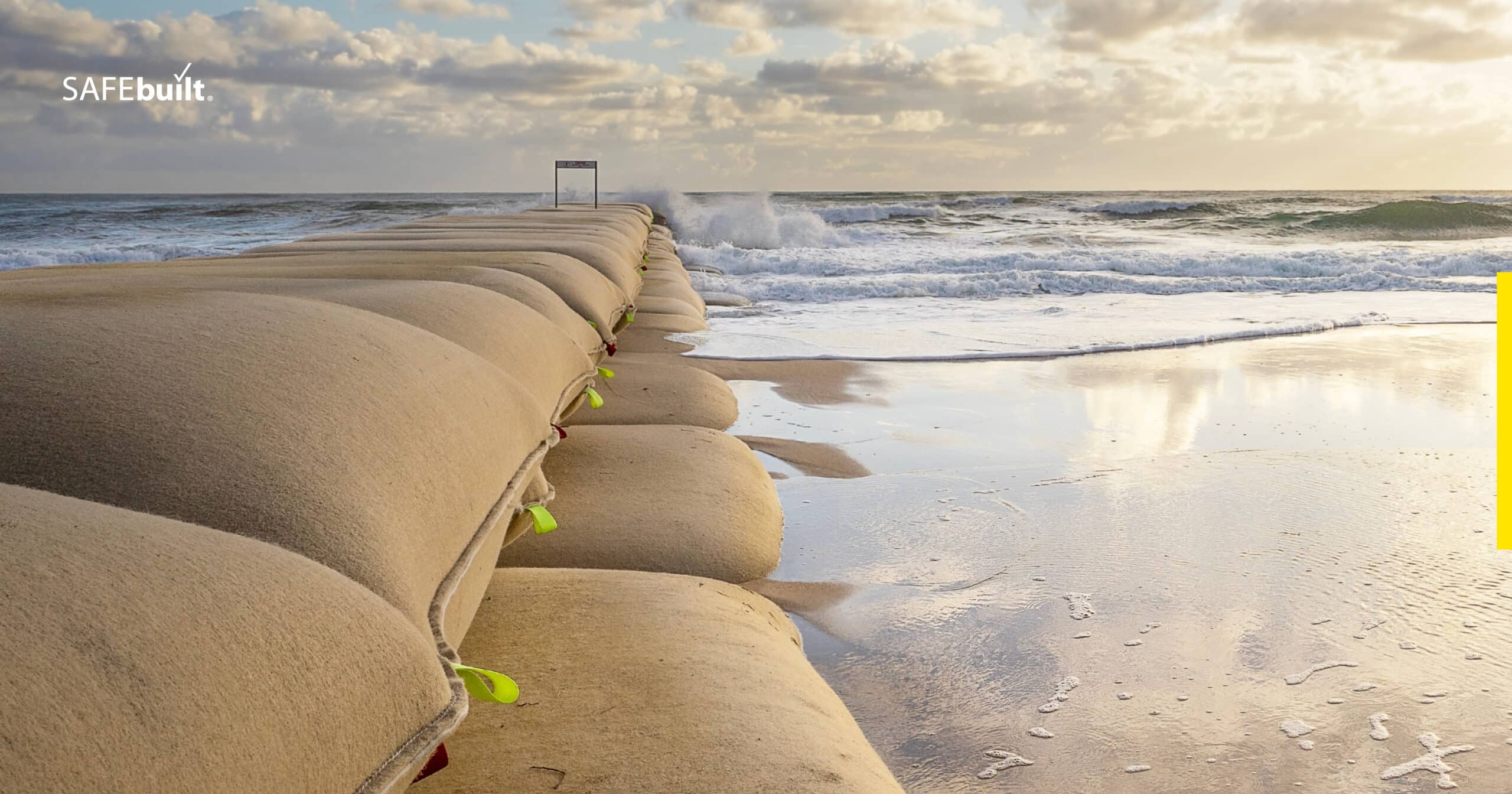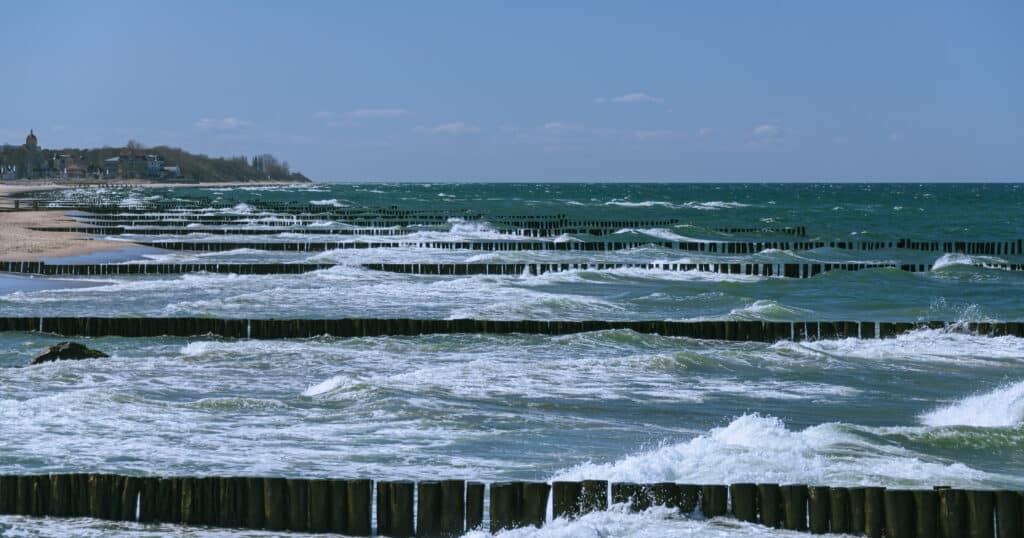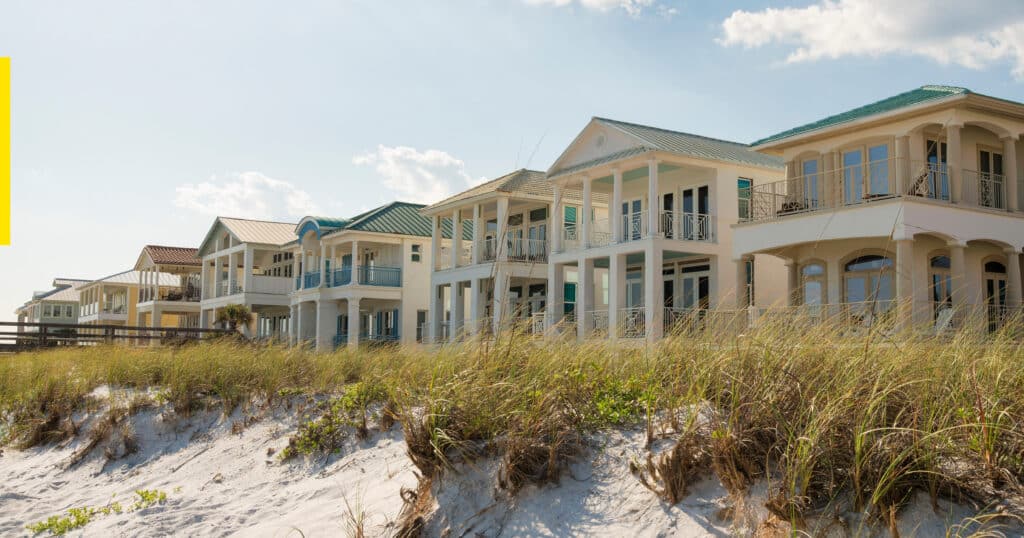
Resources and News How to Prevent Beach Erosion: America’s Changing Shorelines
October 8, 2024
As the 2024 hurricane season peaks, coastal communities across the United States are increasingly concerned about beach erosion. Rising sea levels and more frequent severe storms are reshaping America’s coastlines, threatening infrastructure, ecosystems, and local economies.
Let’s explore how coastal areas are adapting to these challenges and implementing innovative solutions to protect their beaches, including:
- Living shorelines: natural defenses against coastal erosion
- Manmade defenses against erosion
- Community-led efforts
- Resilient coastal community infrastructure
Protecting our shorelines includes protecting our communities
Coastal regions are largely populated and often thrive on fisheries, farming, and tourism. But rising water levels and vanishing beaches are dealing a devastating blow to local communities.

The number of people impacted by shoreline erosion only continues to grow. California tops the coastal populations chart with 26.8 million people living in coastal counties, followed by Florida with 16.2 million, New York with 15.9 million, New Jersey with 7.2 million, and Texas with 6.9 million.

Living shorelines = natural defenses against coastal erosion
Coastal states are increasingly turning to living shorelines, which use natural materials to stabilize coasts while providing habitat benefits. The goal of living shorelines is to protect the coast while also preserving or enhancing the natural ecosystem. They’re generally considered more environmentally friendly than hard structures, though they may not be suitable for all locations or levels of wave energy.
Specific examples of living shorelines include the following:
Beach nourishment
Beach nourishment involves adding sand or sediment to eroding beaches, widening them to create a buffer against erosion. This method offers several key benefits: it immediately restores beaches, preserves their natural aesthetics, enhances recreational value by providing more space for activities, and protects coastal infrastructure from erosion and storm damage.
By mimicking natural beach processes, nourishment maintains the shoreline’s appeal while effectively safeguarding coastal assets.
Up-and-coming developments:
- Use of compatible offshore sand deposits: Coastal engineers are now focusing on finding sand sources that closely match the grain size and composition of the native beach. This ensures better stability and longevity of the nourished beach, reducing the frequency of repeat nourishments.
- Integration with other erosion control methods: Modern beach nourishment projects often incorporate additional elements such as dune restoration, strategic placement of sand-retention structures, or nearshore artificial reefs. This holistic approach provides multiple lines of defense against erosion.
Planting native vegetation
Planting native vegetation, especially on dunes, is an effective method to stabilize shorelines and combat erosion. This natural, eco-friendly approach offers multiple benefits. It enhances biodiversity by providing habitat for local flora and fauna. The diverse plant life improves coastal aesthetics, creating a more vibrant and attractive shoreline. As a cost-effective solution, vegetation requires minimal maintenance once established, making it an economical choice for long-term coastal protection.
Up-and-coming developments:
- Dune restoration initiatives: These projects involve rebuilding and stabilizing sand dunes using native vegetation. Healthy dune systems act as natural buffers against storm surge and wind, while also providing habitat for coastal wildlife.
- Wetland and estuary rehabilitation: Coastal wetlands and estuaries play a crucial role in absorbing wave energy and storm surge. Restoration efforts focus on removing invasive species, replanting native vegetation, and restoring natural water flow patterns to enhance these ecosystems’ protective capabilities.

Manmade defenses = immediate solutions for erosion
While living shorelines offer ecological benefits, local governments often opt for engineered solutions like jetties, groins, or seawalls due to their immediate effectiveness in high-energy environments, ability to protect valuable coastal infrastructure, and longstanding familiarity among coastal engineers and policymakers.
Jetties

Jetties are long, narrow structures extending from the shore into the water, typically built at inlets or river mouths. They help maintain navigable channels by preventing sand from filling them in. Jetties also protect harbor entrances and can create calmer waters for boats.
Benefits:
- Maintain navigation channels
- Protect harbor entrances
- Reduce dredging needs
Groins

Groins are similar to jetties but are usually shorter and built perpendicular to the shoreline. They interrupt longshore currents, trapping sand on their updraft side.
Benefits:
- Accumulate sand on one side of the structure
- Widen beaches in specific areas
- Can be used in series to protect longer stretches of coastline
Breakwaters

Breakwaters are offshore structures, either floating or fixed, that reduce wave energy before it reaches the shore. They create a sheltered area of calmer water behind them.
Benefits:
- Reduces wave impact on the shoreline
- Protects harbors and marinas
- Can promote beach accretion
Community-led efforts allow residents to take action
Many coastal towns are taking matters into their own hands with local initiatives to protect their shores.
Grassroots projects include:
- Homeowner sand fencing programs: Local governments are partnering with property owners to install sand fencing along beachfronts. These fences help capture and accumulate wind-blown sand, building up natural dunes that protect against erosion and storm surges.

- Volunteer-based beach profiling and monitoring: Citizen science programs train local volunteers to regularly measure beach profiles and collect data on shoreline changes. This not only provides valuable data for coastal managers but also increases community awareness and engagement in coastal protection efforts.
Resilient coastal community infrastructure
Many coastal communities facing erosion challenges are reimagining their infrastructure to be more resilient and multifunctional in the face of environmental impacts. These efforts include focusing on:
- Flood-resistant public spaces: New waterfront developments are incorporating flood-resistant designs, such as elevated structures, permeable surfaces, and strategically placed berms. These spaces can withstand occasional flooding while providing recreational areas for the community.
- Green infrastructure for stormwater management: Communities are implementing rain gardens, bioswales, and other green infrastructure elements to manage stormwater runoff. These natural systems help reduce erosion from heavy rains and improve water quality by filtering pollutants before they reach the ocean.

Managed retreat planning
Some coastal areas are beginning to implement managed retreat strategies for areas where erosion is progressing too far to recover. This includes gradually relocating infrastructure and homes away from high-risk zones. If your community is considering a managed retreat plan, these options might benefit you long-term.
- Long-term planning and zoning changes: Communities are updating their comprehensive plans and zoning ordinances to restrict new development in high-risk coastal areas and incentivize inland relocation. This includes creating coastal buffer zones and adjusting building codes to account for future sea-level rise.
- Property buyout programs: Local and state governments are establishing voluntary buyout programs for properties in the most vulnerable areas. These programs offer fair market value for homes, allowing residents to relocate to safer areas while converting high-risk properties into natural buffer zones.
- Restoration of natural coastal habitats: As properties are removed from high-risk areas, these spaces are being restored to their natural state. This may involve replanting native vegetation, reconnecting tidal marshes, or creating dune systems that act as natural barriers against storms and erosion.
Where to go from here
As we face the challenges of climate change and rising sea levels, our approach to coastal protection is evolving. From traditional engineered solutions to innovative living shorelines, communities across America are employing a diverse range of strategies to safeguard their beaches and coastal infrastructure.
At CGA, our landscape architects, civil engineers, and planning experts are experienced in helping coastal communities prepare for the future of ocean-related challenges.
Contact us today and learn how we can bring your vision to life.

